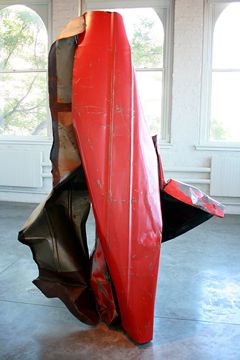In two weeks I am taking a group of students to visit the September 11 exhibition at PS1. Most of the high school students in these two classes have some recollection of 9/11 since they were about five or six years old when it occurred and it goes without saying that for some the memory may be much different than others. So for starters, as I prepare to visit a potentially charged exhibit like this one, I want to be thorough on the “front-end’’ of getting ready. Some of my students may have lost friends or even family members in the attacks and I need to talk with them in advance to discuss how comfortable they are about the trip itself.
With 41 artists represented in this show, many of you may already know that a majority of the work was made prior to 9/11. This is also a good time to tell you that one of our biggest reasons for attending the show is not necessarily to continue reflecting on the events of 9/11, but rather to see how a curator worked with this very specific theme in order to select and assemble a body of work. This approach to organizing an exhibit is much different from a single artist working with a theme or historic event and putting together an exhibit. For the curator, working in this case with a very particular moment in history offers an opportunity to process and represent the range of emotion, confusion, anger and even solidarity that resulted from these attacks. The show allows us to see how Peter Eleey has chosen to visually reflect on the events that took place a decade ago and have us think about the lingering effects.
A few days before we attend the exhibit (and after I speak with any students who have any personal experience with 9/11) classes will view selected images from the show and immediately begin thinking about how and why the works may have been chosen. Asking students to make connections and draw conclusions first is just as important as me filling in the gaps and sharing information that may not be apparent, such as how Christo’s proposal from 1964 to wrap two buildings in lower Manhattan may somehow be symbolic of the particular protection or safety we once felt inside our homes and workplaces.
The day before the trip we will talk about the exact agenda for the visit itself- departure and arrival time, expectations for working in the museum (including whole class discussions and partner work), guidelines and questions for working in their sketchbooks, and of course… lunch plans. I have learned that one of the keys to a solid trip with students involves having as few surprises as possible, so everyone is prepared for what will take place.
During the visit I hope students will take special note of how some artists approach themes such as loss, security, privacy and American identity. I want students to see a breadth of examples where artists, art, media and strategies are also connected by a single element, or in this case, a simultaneously tragic and monumental event. I want students to imagine, as my colleague Jessica Hamlin pointed out, what life may have been like before 9/11.
More to come.
